CHAPTER 13
WHITE QUARTZ CRYSTALS
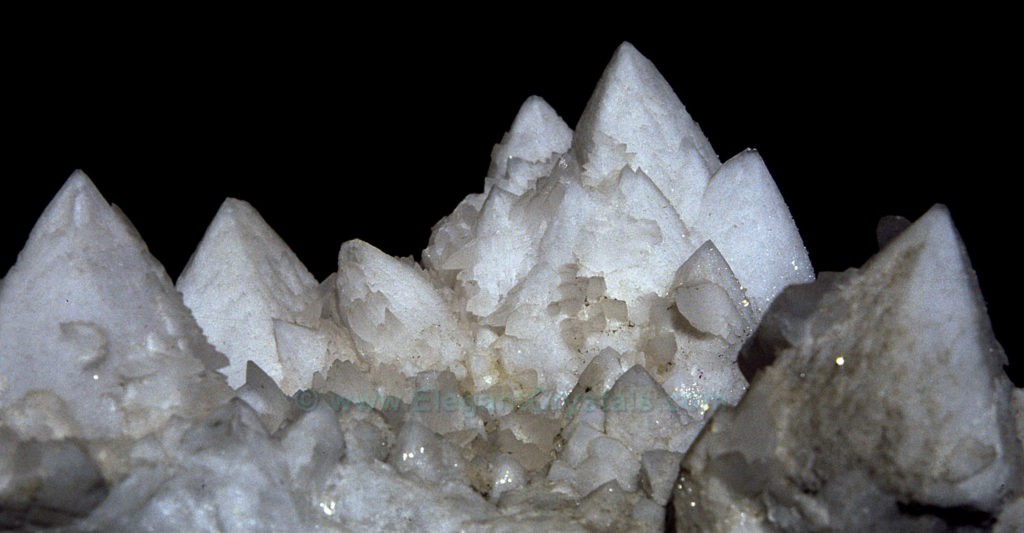
Picture #85
10-inch-wide Colorado White Quartz Cluster
Now that you have seen a wide selection of the shapes that quartz crystals form, I would like to share some images showing the equally wide range of colors found inside quartz crystals and on their surfaces.
We will also take a look at some colors created by a variety of laboratory processes.
I do not think that human-applied colors add anything to the energetic qualities of the crystals.
However, the color enhancements may stimulate your imagination to perform miraculous feats of creativity or healing.
The Colorado cluster shown above is solid white, through and through.
The crystal seems to mimic and perhaps even honor the snow-capped Rocky Mountains where it was found.
Even though the crystal is a white color, it is quite dense and does not transmit light.
When you examine a crystal for the first time, it may look very different depending on whether it is lit from the front or the back.
If you forget to put a light bulb behind it, you may miss some of the crystal’s most important features.
The backlighting will show you exactly how much clarity or translucence the crystal contains.
You may also find that backlighting gives you different colors in the crystal than front lighting.
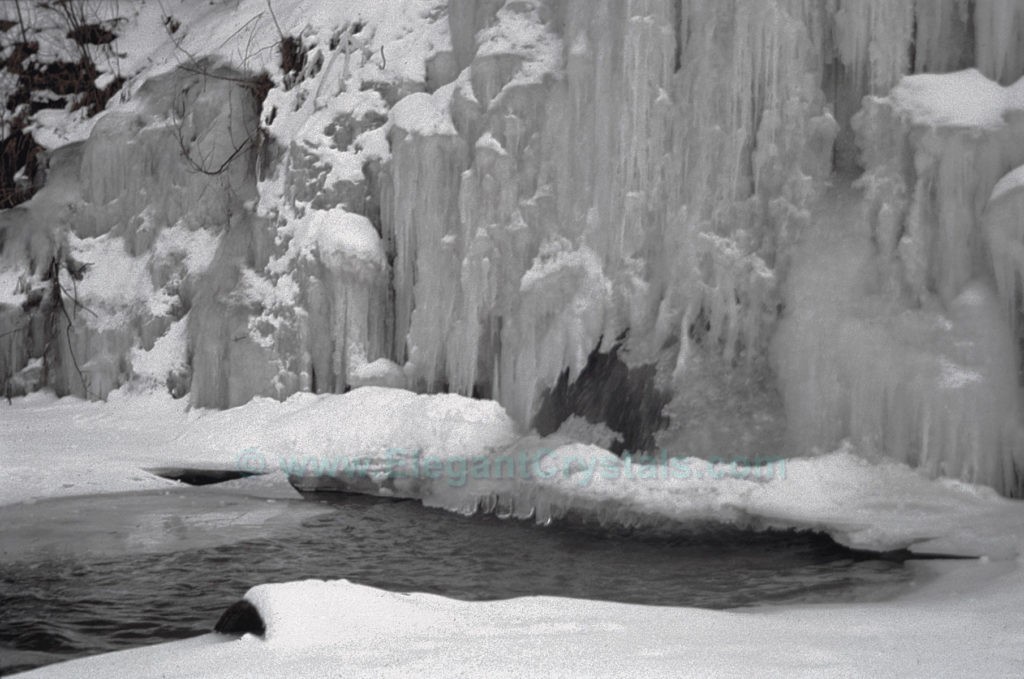
Picture #86
50-foot-tall Frozen Waterfall in Ithaca, New York,
Winter of 1971
Why is this picture in a book on crystals?
You are looking at a frozen waterfall that I photographed in 1971 near Ithaca, New York.
This was my very first glimpse of a giant crystal formation.
That particular year was recorded as the coldest year of the previous century in upstate New York.
This entire 50-foot-tall waterfall had frozen and crystallized over the course of one week.
Perhaps this icy event foreshadowed some of the giant crystals that you will see in upcoming chapters.
This ice flow still rates as the largest natural crystalline mass I have ever seen in person.
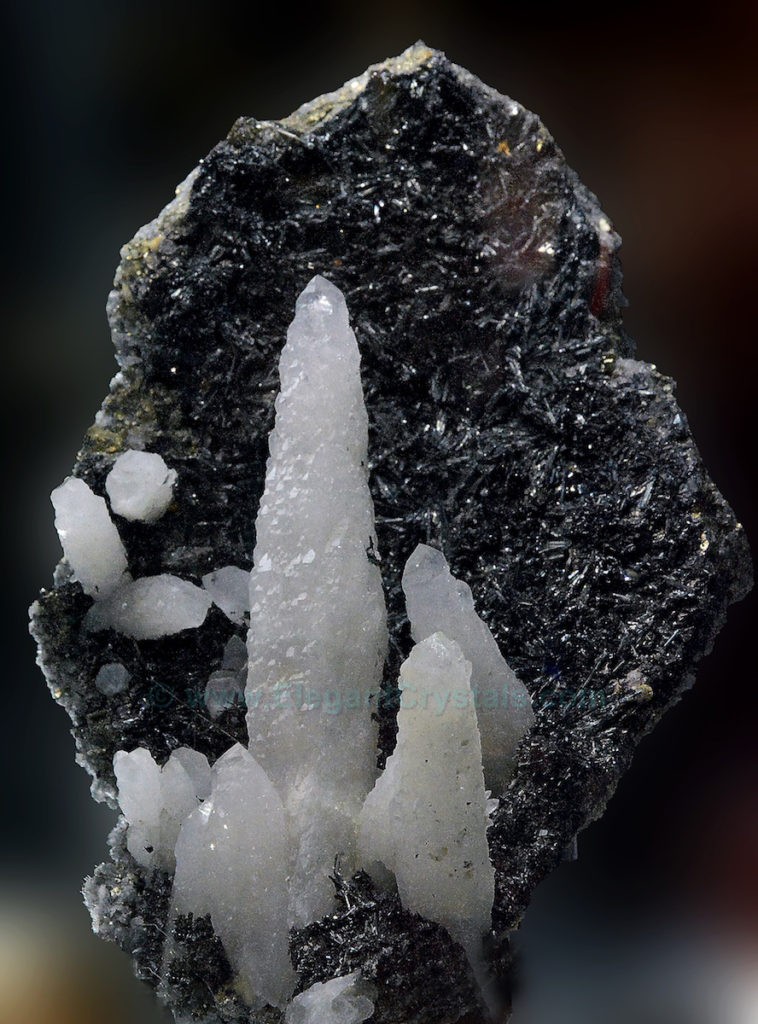
Picture #87
10-inch-tall Brazilian Hopper Quartz on Crystallized Hematite
White quartz crystals are perhaps the most common color of quartz on our planet.
The white color comes from millions of microscopic water and air bubbles inside of the quartz structure.
While there may be zones of clarity in the interior of this piece, there is no way to tell because of the overall translucence or opacity of the quartz.
This particular geode has a series of long white quartz crystals perched roughly in parallel on a background of iron hematite.
It is a very strange color combination for a geode from Brazil.
I particularly like the tall tower, which has hundreds of tiny sparkling facets all lined up in parallel formation.
This unusual kind of crystal castle is sometimes called “hopper quartz.”
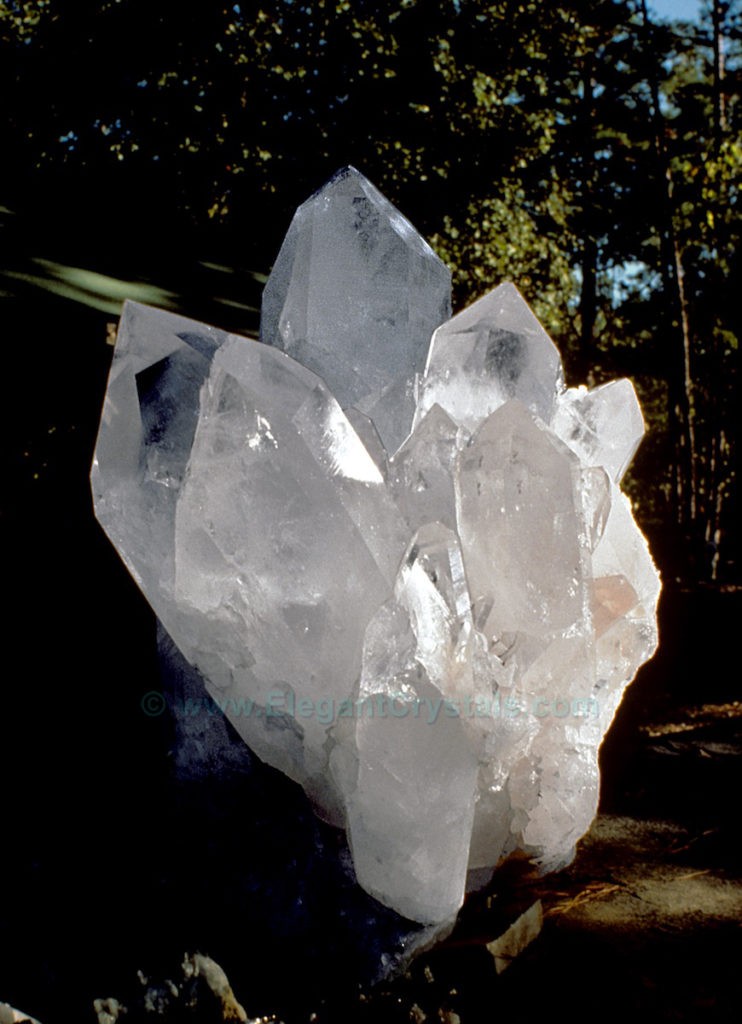
Picture #88
400-pound Quartz Cluster from Paron, Arkansas
This quartz crystal cluster weighs over 400 pounds.
It came from a muddy agricultural field near the town of Paron, Arkansas.
Most of this crystal is a translucent white color that is typical for Arkansas quartz.
The tips of the large individual points have very nice clarity, which is characteristic for crystals in this region.
Generally, smaller crystals are more clear than larger ones.
However, large crystals are occasionally found that are almost ice clear, but this is not the norm.
The discovery of this crystal is an unusual story.
Most quartz is found in dense, red clay.
Typically, a prospector would find pure white boulders sticking out of the ground.
This always indicates a great place to start digging for crystals.
My buddy, Mr. G., noticed that a friend’s field looked like a good location to prospect.
He and the farmer took a bulldozer into the field to uproot white boulders and look for signs of clear crystallization.
The boulders ranged from a few hundred pounds up to a ton or more.
Each time they turned one over they found no crystals on the other side.
Then they turned over this one particular massive boulder.
They instantly noticed numerous, huge crystals that had been buried in the ground.
This was a major find worth thousands of dollars.
All the crystals were perfect, with no chips on the point.
The miners got very excited about the financial possibilities of their new mine.
They proceeded to turn over millions of pounds of boulders and clay as they looked for more of these valuable crystals.
After digging a huge hole over many weeks, they realized there were NO more faceted crystals in the field.
Somehow, this one specimen had grown to an amazing size and shape, yet there were no other collectible crystals on the property.
I suppose they were pleased enough to have one major specimen to sell.
I suspect their disappointment in the lack of other crystals was devastating.
For some reason this location (Paron) has tantalized and teased more than one miner with an early discovery that did not pan out.
My friend Gary Fleck had the exact same experience at a nearby dig.
He immediately unearthed one beautiful crystal in the first few minutes of digging only to be rewarded with a zero-recovery rate for the rest of his efforts.
How do these individual crystals get located in such desolate digging areas?
I imagine earthquakes and mountain upheavals create these geological abnormalities.
The crystals can apparently travel great distances while cushioned in their moist clay beds.
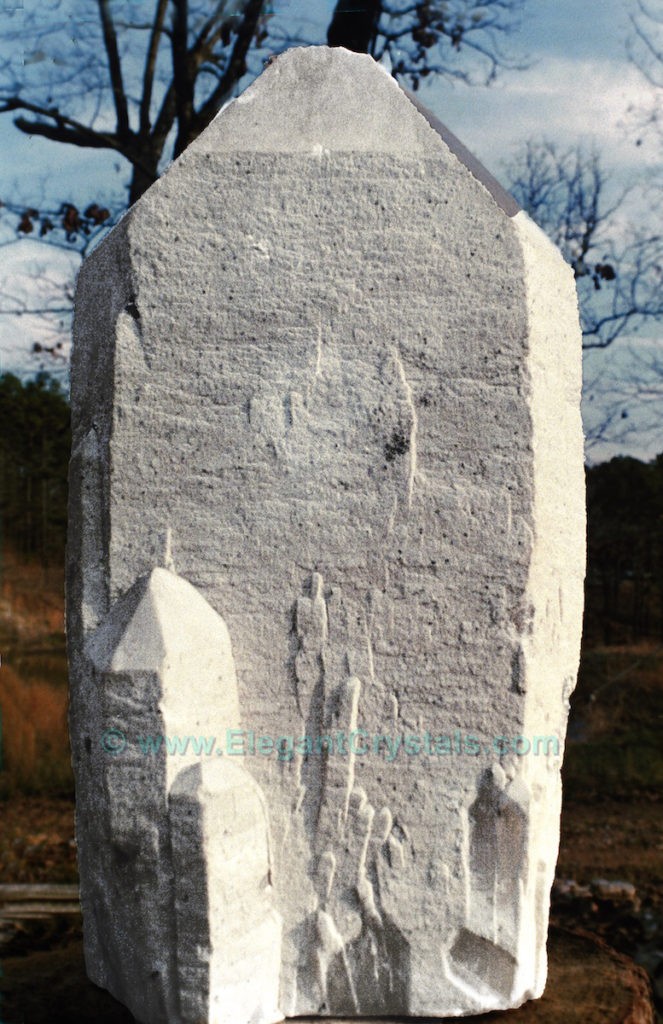
Picture #89
12-inch-tall Brazilian Quartz Crystal with Aluminum Silicate Inclusions
As we work our way through the white crystals of the world, please note this unusual quartz rock from Brazil.
It has very clear crystal inside, but is coated by three millimeters of dense aluminum silicate that blocks any transmission of light.
I had the base cut so it would stand up vertically.
When you find a crystal that stands straight up with a flat base, you’ll know the bottom has been sawed flat for stability.
This shape is generally known as a generator crystal.
Sometimes the bottom facet is polished smooth or it may be left rough cut.
If they did not polish it, you will not be able to see the interior.
Bottom polishing is always a desirable feature in a generator crystal.
It also helps protect your furniture from scratching or gouges.
At one point, I had a whole series of white-coated crystals that I arranged in a row to create a white crystal skyline.
One day I decided to project some color slides onto the white surfaces of the crystal.
This created an excellent movie screen.
I contrasted the white crystal background with vivid images to create a series of fantasy photos.
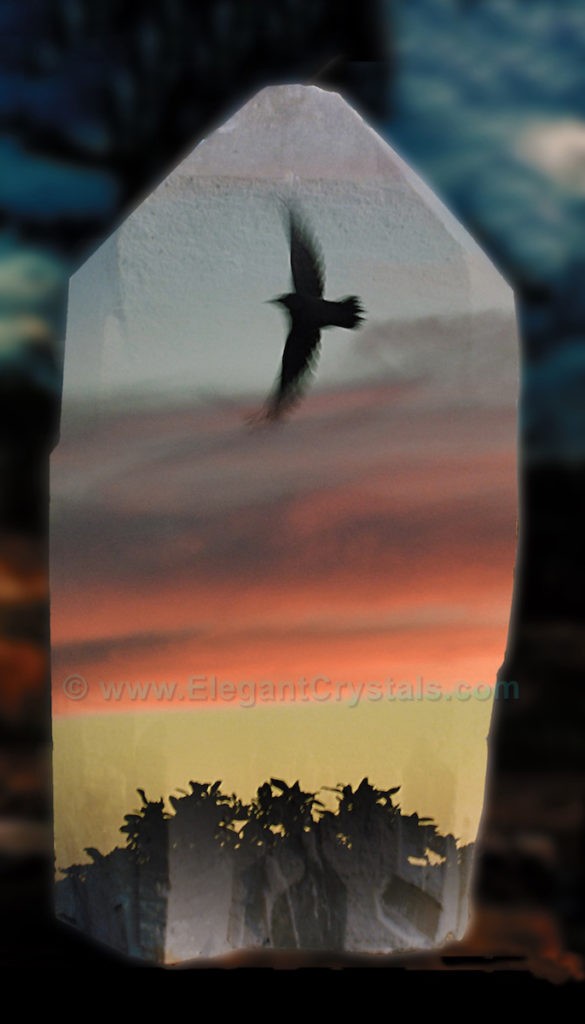
Picture #90
Fantasy Photo of a Silicate Crystal with Projected Images
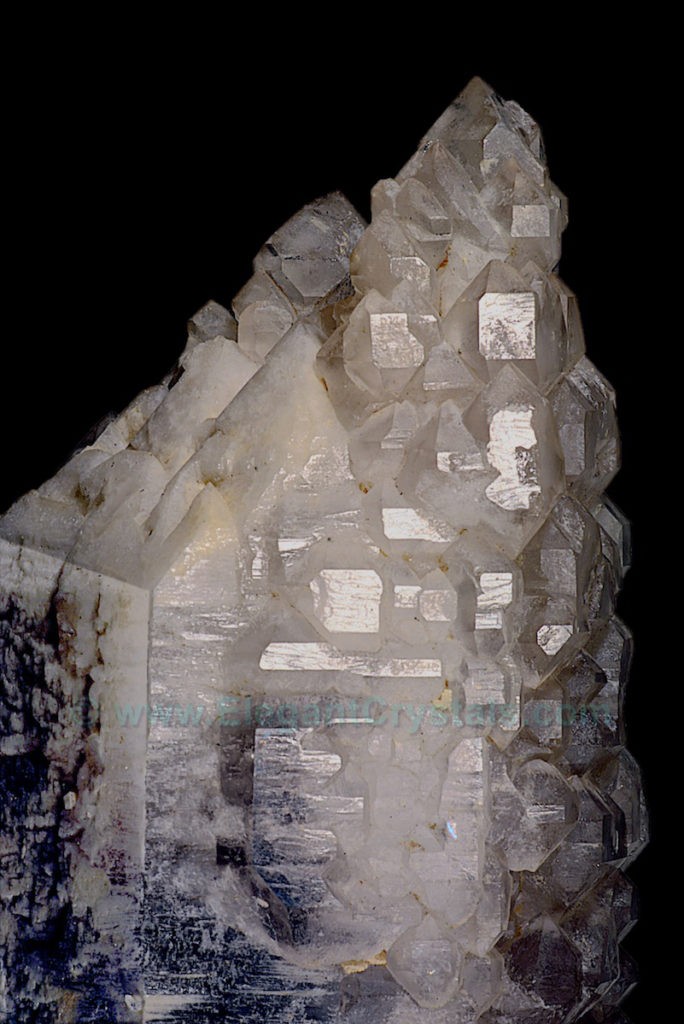
Picture #91
12-inch-tall Gray and White Brazilian Phantom Castle
While parts of this crystal are flat white, there are also zones of gray mineral coatings and smoky quartz.
The complexity of the shape and the blending of the colors make this a unique piece.
Most of the white quartz here is translucent.
In some areas, it incorporates aluminum as it grows.
This creates a shift toward the gray layers, which are less translucent.
As extra aluminum migrates to the outer layers, the mineral becomes quite dense.
There is no visibility inside and no light transmission through the outer layers.
